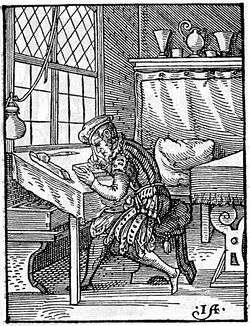Jan Haller


Johann Haller or Jan Haller[1] (1463–1525) is considered one of the first commercial printers in Poland.[2]
Copernicus
Born in Rothenburg, Haller is perhaps best known for publishing in 1509 a volume of poems by Theophylact Simocatta which had been translated from Byzantine Greek by Nicolaus Copernicus. At the time there was no printing press in Copernicus' area—Lidzbark (Heilsberg), Frombork (Frauenburg), Toruń (Thorn)[3]—therefore Copernicus' translation could have been printed only in Breslau (Wrocław), Kraków or farther afield. Copernicus, who had studied in Kraków, opted for Johann Haller, who together with Kasper Hochfeld had already published the first illustrated work in Poland, Jan Łaski's Statutes (1506),[4] and one of 25 works by Laurentius Corvinus (1508). Corvinus had lectured at the Kraków Academy while Copernicus studied there, and they were well acquainted. Corvinus took a job at Thorn, but in June 1509 traveled to the printer Haller in Kraków, bringing with him the manuscript entrusted to him by Copernicus. Corvinus (Rabe) added a poem, and Copernicus wrote a dedication to his uncle, Prince-Bishop of Warmia Lucas Watzenrode. Haller published the book before the end of 1509. Its cover featured the arms of Poland, Lithuania and Kraków.
Haller's life
After his studies at the Kraków Academy, Haller had become a merchant in wine, copper and tin, thus enabling himself to engage, at a later time, in the production of printing elements and finally establishing a printing press in Kraków. His first printing products were almanacs, followed by a breviary for the clergy. Haller acquired a partial monopoly on them, thereby protecting himself from competition. He soon expanded his business to include scientific and scholarly books inn astronomy, mathematics, philosophy and law, as well as royal and church statutes.[3]
Altogether Haller produced 3,530 prints. His masterpieces are illustrated books containing 354 sheets of woodcuts.
See also
Notes
- ↑ Norman Davies, God's Playground: A History of Poland : in Two Volumes, pg. 118
- ↑ (Polish) Epoka publishers,The History of printing till 18th century. First Polish prints. Opole, 2007.
- 1 2 "There was no printing press in Lidzbark, in Frombork, nor in Toruń. The nearest printer shop was in Danzig but only a few works in German were published there. Copernicus' translation had to be printed in Breslau (Wroclaw), Cracow, or abroad. It was opted for the Cracow printer, Jan Haller, who had already published in 1508 one of the 25 works of Corvinus. In June 1509, Corvinus left Thorun bringing with him the manuscript of Copernicus. Johann Haller published it before the end of 1509." — Oliver Thill, Pierre Gassendi, The Life of Copernicus (1473-1543)
- ↑ Norman Davies, God's Playground, vol.1, chapter 5. "The first work printed in Cracow, a Latin almanac, was produced by Piotr Straube in 1473. In 1491, Swejbold Vehl printed the first ever book in Cyrillic, an Oktoich hymnal, and was fined by an inquisitorial court for his pains. Johann Haller, another Franconian, and Kasper Hochfeld, had the distinction of publishing Poland's first illustrated work, Jan Laski's legal 'Statutes', in 1506."
External links
| Wikimedia Commons has media related to Johann Haller. |
- Communicating Europe to the Region: Breslau in the Age of the Renaissance Lambrecht, German History, 2002 (pdf file)